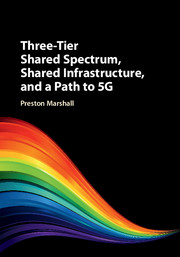Book contents
- Frontmatter
- Contents
- Acknowledgments
- Preface
- Part I Spectrum Sharing Background
- Part II Three-Tier Dynamic Spectrum Models
- Part III Components of a Three-Tier Architecture
- Part IV Protection Processes for Incumbents and Peers
- Part V Example Use of Three-Tier Spectrum: Use of the 3.5 GHz CBRS Band in the USA
- 13 Device and Network Interaction with the Spectrum Access System
- 14 CBRS SAS Requirements
- Part VI Future Bands, Network Services, Business Models, and Technology
- Part VII Appendices
- Index
- References
13 - Device and Network Interaction with the Spectrum Access System
from Part V - Example Use of Three-Tier Spectrum: Use of the 3.5 GHz CBRS Band in the USA
Published online by Cambridge University Press: 30 August 2017
- Frontmatter
- Contents
- Acknowledgments
- Preface
- Part I Spectrum Sharing Background
- Part II Three-Tier Dynamic Spectrum Models
- Part III Components of a Three-Tier Architecture
- Part IV Protection Processes for Incumbents and Peers
- Part V Example Use of Three-Tier Spectrum: Use of the 3.5 GHz CBRS Band in the USA
- 13 Device and Network Interaction with the Spectrum Access System
- 14 CBRS SAS Requirements
- Part VI Future Bands, Network Services, Business Models, and Technology
- Part VII Appendices
- Index
- References
Summary
Introduction
This chapter summarizes the design of the United States (US) Citizens Broadband Radio Service (CBRS) device to Spectrum Access System (SAS) interaction. The US standards have been developed by theWireless Innovation Forum (WinnForum) through collaboration between its membership, including Mobile Network Operators (MNO), Mobile System Operator (MSO), equipment suppliers, SAS operators, and incumbent system users.
This discussion is not intended as a recipe for how three-tier regimes must be implemented. Instead, it is presented as a starting point for other implementations to consider this design, and, hopefully, further extend it, or adapt it to meet different objectives. Certainly, there are cost advantages if, all things being equal, there is a degree of harmonization of these mechanisms internationally. It will also serve to make the more general or abstract discussions more concrete and explicit.
This chapter will summarize the design, and the rationale for this design. However, it is not intended to be sufficient for CBRS design or development, and is intended to familiarize the reader with the frameworks selected for this first implementation of the three-tier concept. The complete hierarchy of objects and containers is not represented fully, but abstracted to discuss the information content of the exchanges, rather than their implementation.
It is also worth noting that all of these interfaces are defined consistent with Internet Engineering Task Force (IETF) internet standards, including the Internet Protocol (IP) standard. Rather than utilize any specific wireless technology standard, such as the Third-Generation Partnership (3GPP) Long-Term Evolution (LTE) layer 2 interfaces, the three-tier devices, or their proxies, operate on IP network backhaul. This supports operation over any public or private IP network. Similarly, the upper layer security protocols are specific to IP Transport Layer Security (TLS)/Secure Socket Layer (SSL). This is a significant departure from past telecommunications practice, which typically deployed access point networks over unique layer 2 interfaces.
As the design evolved, the CBRS community implicitly established a consensus around the following list of design objectives:
1. Assured device shutdown, or relocation, when directed, was essential to assure protected users of the integrity of the protection methodology.
2. SAS interaction must be technology neutral, and capable of supporting any reasonable technology in the band, and not limit future innovation.
3. Avoid requiring any substantial changes in the design of the Radio Access Network (RAN) or upper layers, in order to fully exploit the existing high-volume commercial products.
- Type
- Chapter
- Information
- Publisher: Cambridge University PressPrint publication year: 2017



